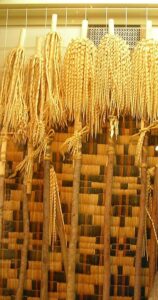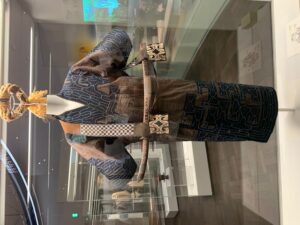This is the second part of a series based around the writings of the remarkable Isabella Bird, who visited Japan in 1878. In Part One she is taken by some Ainu villagers to visit a hill shrine dedicated to Yoshitsune, the medieval warrior. In the passage below, taken from p.274-5 of Unbeaten Tracks in Japan, she discusses nature worship and Ainu gods. (The libations of saké, sprinkled in different directions is the same purification rite as in Siberian shamanism.)
**************
There cannot be anything more vague and destitute of cohesion than Ainu religious notions. With the exceptions of the hill shrines of Japanese construction dedicated to Yoshitsune, they have no temples, and they have neither priests, sacrifices, nor worship. Apparently though all traditional time their cultus has been the rudest and most primitive form of nature-worship, the attaching of a vague sacredness to trees, rivers, rocks, and mountains, and of vague notions of power for good or evil to the sea, the forest, the fire, and the sun and moon. I cannot make out that they possess a trace of the deification of ancestor, though their rude nature worship may well have been the primitive form of Japanese Shinto. The solitary exception to their adoration of animate and inanimate nature appears to be the reverence paid to Yoshitsune, to whom they believe they are greatly indebted, and, it is supposed by some, will yet interfere on their behalf.

Their gods – that is the outward symbols of their religion, corresponding most likely with the Shinto gohei – are wands and posts of peeled wood, whitted nearly to the top, from which the pendent shavings fall down in white curls. These are not only set up in their houses, sometimes to the number of twenty, but on precipices, banks of river and streams, and mountain-passes, and such wands are thrown into the rivers as the boatmen descend rapids and dangerous places.
…………..
I have taken infinite trouble to learn from themselves what their religious notions are, and Shinondi tells me that they have told me all they know, and the whole sum is a few vague fears and hopes, and a suspicion that there are things outside themselves more powerful than themselves, whose good influences may be obtained, or whose evil influences may be averted, by libations of saké.

The word worship is in itself misleading… it simply means libations of saké, waving bowls and waving hand, without any spiritual act of deprecation or supplication. In such a sense an such alone they worship the sun and moon (but not the stars), the forest, and the sea. the wolf, the black snake, the owl and several other beasts and birds have the kamoi, god, attached to them, as the wolf is ‘the howling god’, the owl ‘the bird of the gods,’ a black snake the ‘raven god’; but none of these things are now ‘worshipped,’ wolf-worship having quite lately died out. Thunder, ‘the voice of the gods,’ inspires some fear. The sun, they say, is their best god, and the fire their next best, obviously the divinities from whom their greatest benefits are received. Some idea of gratitude pervades their rue notions, as in the case of the ‘worship’ paid to Yoshitsune, and it appears in one of the rude recitations chanted at the Saturnalia which in several places conclude the hunting and fishing seasons; –
‘To the sea which nourishes us, to the forest which protects us, we present our grateful thanks. You are two mothers that nourish te same child; do not be angry if we leave one to go to the other.
‘The Ainus will always be the pride of the forest and of the sea.
The solitary act of sacrifice which they perform is the placing of a worthless, dead bird, something like a sparrow, near one of their peeled wands, where it is left till it reaches an advanced stage of putrefaction. ‘To drink for the god’ is the chief act of “worship,” and thus drunkenness and religion are inseparably connected, as the more saké the Ainus drink the more devout they are, and the better pleased are the gods. It does not appear that anything but saké is of sufficient value to please the gods. The libations to the fire and the peeled post are never omitted, and are always accompanied by the inward waving of the saké bowls.


Very interesting, doesn’t seem like there’s much to their worship but sake.
Hah, I think there is much more than sake but that is their way of getting in touch with the invisible spirits in which they believe. Intoxication in one form or another is often used in religions to heighten states of mind…
Hah, I suppose if you focussed on the wilder matsuri, you could say that of Shinto too…